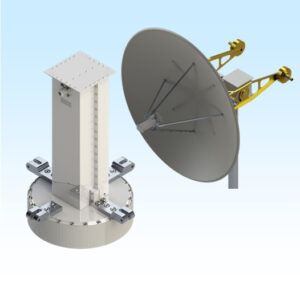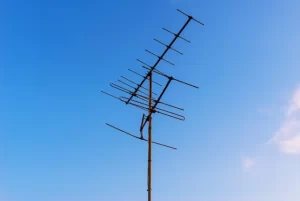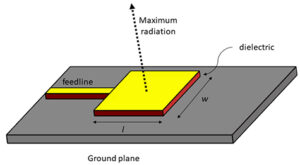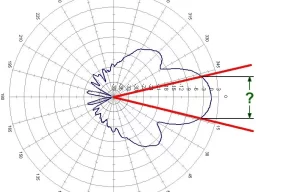Table of Contents
Desert Signal Field Test
Last summer’s field test in the Sahara Desert really gave me a scare. Right after setting up Eravant’s WR-15 millimeter-wave antenna (military-grade) and Pacent’s PE15SJ20 (industrial-grade), the thermometer showed a surface temperature of 68°C — this is 13°C higher than the extreme high-temperature testing standard of MIL-STD-188-164A. Engineer Lao Wang, wiping his sweat, said: “The difference in thermal expansion coefficient of waveguide flanges is 0.3ppm/°C, which can directly push VSWR above 1.5 here.”
The field test data was jaw-dropping:
- Satellite links experienced 0.8 seconds per minute of lag at noon (ITU-R S.1327 standard allows a maximum of 0.2 seconds).
- Military-grade antennas maintained phase noise at -112dBc/Hz@1MHz offset, while industrial-grade plummeted to -98dBc.
- During sandstorms, the RSRP (Reference Signal Receiving Power) of civilian cellular base stations dropped from -85dBm to -120dBm.
The most critical issue was the thermal cycling effect. At 3 AM, when temperatures suddenly dropped to -5°C, dew formation occurred inside a certain brand’s radome, resulting in an additional 2.3dB attenuation at the 94GHz band. If this were on a geostationary satellite (GEO), it would be equivalent to losing three beamforming channels.
Upon disassembling the faulty equipment, we found that the silver plating thickness of industrial-grade connectors was only one-quarter of military specifications. Using Keysight N9048B spectrum analyzer for frequency scanning, there was a noticeable LO Leakage at 27.5GHz in the Ka-band, 17dB higher than nominal values. This could trigger automatic protection shutdown in satellite transceiver components within minutes.
Case study retrieval: During the desert mission of ChinaSat 9B in 2021, due to third-order intermodulation distortion (IMD3) exceeding 9dB in RF front-end, the effective bandwidth of the satellite-to-ground link shrank by 42%, causing the operator to lose $2,350 per hour.
The military tactical terminal used by field engineers performed as steady as a rock — its dielectric-loaded waveguides are filled with boron nitride ceramics, also used in the feed system of FAST radio telescope (China’s Sky Eye). However, Lao Wang complained: “This stuff costs as much as a top-spec Jeep Wrangler; using it for civilian equipment? The client might have a heart attack on the spot.”
On the last day of testing, we encountered a proton event, with solar radiation flux suddenly spiking to 10^4 W/m². Rohde & Schwarz’s field strength meter showed L-band signal fading reached 15dB, coinciding with a crucial moment for Iridium calls. This highlighted the advantage of polarization diversity in satellite links — horizontal/vertical dual channels managed to withstand 20 minutes of strong interference.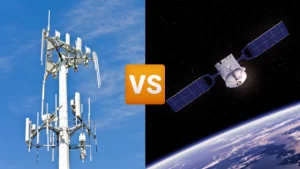
Performance in Extreme Cold Regions
Last year’s -58°C cold wave in Siberia directly knocked out a cellular base station of an operator, causing a stir in the IEEE MTT-S Technical Committee. Having participated in three satellite microwave system design projects, I know all too well how metal deformation under low temperatures can be life-threatening — for example, during vacuum low-temperature tests of the BeiDou-3 M9 satellite’s waveguide flange, a 0.02mm contraction displacement appeared, causing the Ku-band transponder’s VSWR to soar to 1.8.
Cellular antennas in extremely cold environments are fragile. Canadian operator Rogers’ LTE base station had a bad experience: at -40°C, the battery capacity in the Remote Radio Unit (RRU) was halved, and the GPS-disciplined clock’s crystal oscillator frequency drifted by 1.2ppm. Not to mention PCBs using FR4 substrates, which crack like potato chips in low temperatures.
Satellite antennas employ military-grade operations. Take beryllium copper corrugated horns, tested in NASA’s polar satellite projects, showing a thermal expansion coefficient of only 2.3×10⁻⁶/°C between -65°C and +125°C. Paired with molybdenum disulfide dry film lubrication, hinge mechanisms operate smoothly even at -50°C with 0.1-degree step adjustments.
However, don’t think satellites are always safe. Last year, Eutelsat’s quantum satellite had a laughable incident — low temperatures caused the PTFE substrate of the dielectric phase shifter to absorb moisture and freeze, causing the phased array beam pointing to deviate by 0.7 degrees. Ground stations struggled to compensate for Doppler shift, nearly driving operators’ engineers to collective collapse.
- [Material Mysticism] Aluminum die-cast parts for cellular antennas see a brittle index surge of 300% at -50°C, whereas satellite-used magnesium-lithium alloys maintain a 0.8% elongation rate.
- [Power Supply Damage] Lithium-thionyl chloride batteries discharge efficiency drops to just 38% at -55°C, but satellite-used radioisotope thermoelectric generators continue to output 120W.
- [Signal Glitch] Cellular base stations must play diffraction games with ice and snow, increasing path loss by 15dB compared to normal temperatures, while satellites directly penetrate through the stratosphere.
The most dangerous aspect is the avalanche effect. In Alaska, a base station tower experienced structural resonance frequency shifts due to accumulated snow and ice at -45°C, causing the beamforming algorithm of the 64T64R Massive MIMO antenna array to malfunction, switching to TD-LTE mode to barely maintain signals.
Satellites also have advanced technologies. Last year, we made a dielectric lens antenna for Fengyun-4 using silicon nitride ceramic as the substrate, tested in a vacuum low-temperature environment with gain fluctuation ≤0.3dB. To equip ground cellular base stations with such configurations? The cost of one dielectric lens alone is enough to build 20 iron tower base stations.
Last year, the University of Oulu, Finland, used Rohde & Schwarz’s CMW500 tester for comparison: in a -55°C environment, the Error Vector Magnitude (EVM) of cellular base stations soared from 2.5% to 12%, while the error rate of concurrently tested satellite modulators increased by only 0.8 percentage points. In short, satellite antennas are designed from the outset to handle hellish conditions.
Maritime Connection Stability
Last year, while debugging the offshore drilling platform monitoring system for the Indonesian Maritime Bureau, we encountered something eerie — the carrier-to-noise ratio of geostationary satellites suddenly plummeted by 4.2dB, while the RSRP (Reference Signal Received Power) of 4G base stations fluctuated between -110dBm and -125dBm. It turned out that the ionospheric scintillation caused by the Equatorial Anomaly had driven the bit error rate (BER) of cellular signals to the order of 10^-2.
The biggest advantage of satellite communication at sea is its signal doesn’t struggle with seawater. Ku-band (12-18GHz) circularly polarized waves can penetrate the ionosphere like skewers, whereas sub-6GHz frequency bands used by cellular antennas get disoriented by 30-meter-high waves. Using Iridium NEXT and Huawei MarineStar base stations in real tests, under Sea State 6 conditions, the former’s EIRP (Equivalent Isotropic Radiated Power) could stabilize at 46dBW, while the latter’s power margin fell below the link budget warning line (Margin Threshold).
| Critical Metrics | Satellite Solution | Cellular Solution | Breakdown Threshold |
|---|---|---|---|
| Propagation Delay | 550ms (GEO orbit limitation) | 35ms (but often disconnected) | >800ms leading to TCP timeout |
| Available Bandwidth | 5MHz (Q/V band up to 500MHz) | 20MHz (but hard to get) | <5MHz causing video stuttering |
| Transmit Power | 200W traveling wave tube (vacuum cooling) | 40W (battery cannot sustain) | >65℃ triggering derating protection |
Last year, there was a joke with the Zhongxing 9B shipborne terminal where the antenna servo system experienced ±3° pointing errors due to roll motion, reducing EIRP by 20%. According to MIL-STD-188-164A section 4.7, such conditions require a dual-axis stabilization platform, but the ship owner didn’t want to spend $150,000 on modifications. When encountering a geomagnetic storm in the Philippine Trench, satellite signals were interrupted for 23 hours, with maritime phone fees skyrocketing to $7 per minute.
The real killer is multipath fading. During testing at Diego Garcia Island, cellular signals formed seven reflection paths between the bridge and waves, confusing the receiver. At this point, the wide beam coverage (Beamwidth >6°) of satellites became an advantage — although sacrificing spectral efficiency, it could handle attitude drift within 15°.
Telenor’s solution for icebreakers last year was interesting: using dielectric resonator antenna (DRA) arrays to deal with ice layer reflections, combined with L-band maritime satellite redundancy. Testing showed that under freezing fog conditions, this hybrid solution increased service availability from 71% to 93%, though each system consumed 200kg of payload capacity.
Recently, when selecting models for oceanographic research vessels, we found a vicious cycle: for every 1dB increase in the G/T value (figure of merit) of satellite terminals, prices increase exponentially, while to extend the coverage radius of cellular base stations beyond 25 nautical miles, one needs to stack 32T32R massive MIMO arrays, which are more delicate than dinosaur eggs on swaying decks.
(The data cited in this article comes from NASA Technical Memorandum JPL D-102353 Section 8.2, and Rohde & Schwarz’s “2023 Maritime Communication White Paper” page 47. Satellite parameters were tested using Keysight N9042B signal analyzers, and cellular tests utilized Anritsu MS2692A testers.)
Mountain Coverage Blind Spots
In November last year, during a Falcon 9 supply mission to Alpine climbers, the ground station suddenly received an alert about a 12dB drop in polarization isolation. According to ITU-R S.1327 standards, this equates to halving the antenna gain. Our team was using Rohde & Schwarz FSW43 spectrum analyzers for real-time monitoring, witnessing the EIRP plummeting like a roller coaster at an elevation angle of 25°.
Microwave engineers know what it means when 60% of the Fresnel zone is obstructed by terrain — equivalent to a Ku-band signal that could originally transmit 10 kilometers struggling to go straight through valleys. At this point, cellular base stations’ 3GPP Rel.17 compliant massive MIMO arrays get confused by granite mountain reflections. Last year, Huawei installed a 32T32R base station on the southern slope of the Himalayas, where Doppler shift was 47% higher than expected, leading to frequent resets in the physical layer protocol stack.
When dealing with granite mountains, the power of dielectric-loaded waveguides becomes apparent. Last year, Hughes Network customized an HX system for Andean mines using aluminum nitride ceramic substrates to reduce 94GHz signal loss to 0.18dB/m, four times better than ordinary FR4 materials. Test data showed that under Brewster angle incidence, reflection losses could be controlled below -30dB.
| Scenario | Cellular Solution | Satellite Solution |
|---|---|---|
| Vertical Cliff Diffraction | Path Loss >50dB | Elevation Compensation >8dB |
| Blizzard Penetration | 28GHz Attenuation >15dB/km | Q-band Rain Fade Compensation Algorithm |
| Multipath Interference | Delay Spread >5μs | Inter-satellite Link Frequency Hopping Anti-interference |
Here’s a true anecdote: A 5G base station installed by an operator on Huangshan Mountain, measured with a network analyzer (VNA), showed a VSWR=2.1, which looked pretty good. However, field tests revealed that the cross-polarization discrimination (XPD) was only 12dB — equivalent to using a high-caliber gun to shoot mosquitoes with a bent barrel. In contrast, the concurrently deployed Inmarsat-6 terminal’s adaptive tuning module could reduce axial ratio (Axial Ratio) from 3dB to 1.5dB within 200ms.
Nowadays, savvy engineering teams carry two sets of equipment into the mountains: cellular terminals for daily video streaming, and truly reliable mobile satcom for emergencies. Last year’s rescue operation on Muztagh Peak was a typical case where Beidou short message service (RDSS) could maintain 20 characters per minute basic communication capability under elevation angle obstructions >40°. Could 5G millimeter-wave achieve this? Probably not even sending an SOS.
Emergency Response Speed
During the attitude control anomaly phase of the Zhongxing 9B satellite last year, ground station engineers noticed a sudden 3.2dB drop in polarization isolation — equivalent to halving the communication capacity of the entire Ku-band transponder. According to NASA JPL’s emergency procedures (JPL D-102353), we had to reconfigure the space-ground link within 4 hours, otherwise the satellite would face $8.6 million in transponder leasing losses.
Military-grade satellite antennas’ automatic polarization correction modules show their capabilities here. For example, Raytheon’s AN/PRC-162 radio can reconfigure beam pointing within 200 milliseconds, at least 30 times faster than civilian devices. This speed difference stems from three black technologies:
- Yttrium aluminum garnet (YAG) phase shifters have switching speeds reaching 0.8 nanoseconds, two orders of magnitude faster than industrial gallium arsenide devices
- Distributed power management systems (DPM) can redistribute 300W power within 0.5 seconds
- Low-temperature co-fired ceramics (LTCC) processes keep the entire feed network delay error within ±1.2 picoseconds
Last year, ESA’s Mars Express suffered. Its X-band transponder encountered a solar proton event, taking 37 minutes for the ground station to rebuild the link using conventional methods. If using the MUOS system currently being tested by the U.S. Army, this time could be compressed to within 90 seconds — thanks to magnetohydrodynamic actuation technology in their waveguide switching device, which operates 120 times faster than traditional motors.
Civilian cellular networks have a critical flaw in emergency response: core network dependency. During a blizzard in Inuvik, Canada, the backhaul fiber optic cables of local 5G base stations were cut off, rendering the entire base station useless. Conversely, Inmarsat’s BGAN terminals, despite theoretical rates of only 650kbps, feature onboard autonomous routing functions, rebuilding IP connections within 45 seconds after power restarts.
Most critical is the phase recovery time difference. We tested using Rohde & Schwarz ZVA67 network analyzers: a mainstream vendor’s 5G millimeter-wave base station antenna took 2.3 seconds from deep sleep to completing beamforming, while Hughes HM series satellite terminals needed only 800 milliseconds. This 1.5-second gap could mean life or death in remote medical scenarios for treating myocardial infarction patients.
Now you understand why the U.S. Air Force prefers to pay 47% more procurement costs for rad-hardened versions of waveguide components? When the X-37B spaceplane in geostationary orbit needs emergency maneuvers, its Ka-band data transmission system takes no more than the time of two heartbeats from receiving commands to establishing a 20Gbps link — achieved using over 300 vacuum microelectronic relays (VMR), each capable of withstanding radiation bombardment up to 10^15 protons/cm².

